Biofuel
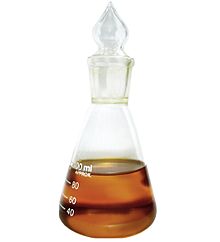
| Part of a series on |
| Renewable energy |
|---|
 |
Biofuel is a fuel that is produced over a short time span from biomass, rather than by the very slow natural processes involved in the formation of fossil fuels, such as oil. Since biomass can be used as a fuel directly (e.g. wood logs), some people use the words biomass and biofuel interchangeably. However, the word biofuel is usually reserved for liquid or gaseous fuels used for transportation. The United States Energy Information Administration (EIA) follows this naming practice.[1][not in body]
Biofuel can be produced from plants or from agricultural, domestic or industrial biowaste.[2] The greenhouse gas mitigation potential of biofuel varies considerably, from emission levels comparable to fossil fuels in some scenarios to negative emissions in others.
The two most common types of biofuel are bioethanol and biodiesel. The U.S. is the largest producer of bioethanol, while the EU is the largest producer of biodiesel. The energy content in the global production of bioethanol and biodiesel is 2.2 and 1.5 EJ per year, respectively.[3]
- Bioethanol is an alcohol made by fermentation, mostly from carbohydrates produced in sugar or starch crops such as corn, sugarcane, or sweet sorghum. Cellulosic biomass, derived from non-food sources, such as trees and grasses, is also being developed as a feedstock for ethanol production. Ethanol can be used as a fuel for vehicles in its pure form (E100), but it is usually used as a gasoline additive to increase octane ratings and improve vehicle emissions.
- Biodiesel is produced from oils or fats using transesterification. It can be used as a fuel for vehicles in its pure form (B100), but it is usually used as a diesel additive to reduce levels of particulates, carbon monoxide, and hydrocarbons from diesel-powered vehicles.[4]
In 2019, worldwide biofuel production provided 3% of the world's fuels for road transport, and a very small amount of aviation biofuel. The International Energy Agency (IEA) wants biofuels to make up 64% of the world demand for transportation fuels by 2050, in order to reduce dependency on petroleum.[5] However, the production and consumption of biofuels are not on track to meet the IEA's sustainable development scenario.[6] From 2020 to 2030 global biofuel output has to increase by 14% each year to reach IEA's goal.[7]
Generations

First
First-generation biofuels are fuels made from food crops grown on arable land. The crop's sugar, starch, or oil content is converted into biodiesel or ethanol, using transesterification, or yeast fermentation.[8]
Up to 40% of corn produced in the United States is used to make ethanol,[9] and worldwide 10% of all grain is turned into biofuel.[10] A 50% reduction in grain used for biofuels in the US and Europe would replace all of Ukraine's grain exports.[11]
Second
Second-generation biofuels are fuels made from lignocellulosic or woody biomass, or agricultural residues/waste. The feedstock used to make the fuels either grow on arable land but are byproducts of the main crop, or they are grown on marginal land.[12] Second-generation feedstocks include straw, bagasse, perennial grasses, jatropha, waste vegetable oil, municipal solid waste and so forth.[13] The use of this class of biofuels is thought to increase environmental sustainability, since the non-food part of plants is being used to produce second-generation biofuels, instead of being disposed.[14] But the use of this class of biofuels increases the competition for lignocellulosic biomass, increasing the cost of producing these biofuels.[15] Although the use of this class of biofuels reduces carbon emissions, their use does not yield net zero carbon emission.[16]
Third
Algae can be produced in ponds or tanks on land, and out at sea.[17][18] Algal fuels have high yields,[19] can be grown with minimal impact on fresh water resources,[20][21] can be produced using saline water and wastewater, have a high ignition point,[22] and are biodegradable and relatively harmless to the environment if spilled.[23][24] Production requires large amounts of energy and fertilizer, the produced fuel degrades faster than other biofuels, and it does not flow well in cold temperatures.[17] By 2017, due to economic considerations, most efforts to produce fuel from algae have been abandoned or changed to other applications.[25]
Fourth
This class of biofuels includes electrofuels[citation needed] and solar fuels. Electrofuels are made by storing electrical energy in the chemical bonds of liquids and gases. The primary targets are butanol, biodiesel, and hydrogen, but include other alcohols and carbon-containing gases such as methane and butane. A solar fuel is a synthetic chemical fuel produced from solar energy. Light is converted to chemical energy, typically by reducing protons to hydrogen, or carbon dioxide to organic compounds.[26]
Fourth-generation biofuels also include biofuels that are produced by bioengineered organisms i.e. algae and cyanobacteria.[27] Algae and cyanobacteria will use water, carbon dioxide, and solar energy to produce biofuels.[27] This method of biofuel production is still at the research level. The biofuels that are secreted by the bioengineered organisms are expected to have higher photon-to-fuel conversion efficiency, compared to older generations of biofuels.[27] One of the advantages of this class of biofuels is that the cultivation of the organisms that produce the biofuels does not require the use of arable land.[28] The disadvantages include the cost of cultivating the biofuel-producing organisms being very high.[28]
Environmental impact
Estimates about the climate impact from biofuels vary widely based on the methodology and exact situation examined.[29]
In general, biofuels emit fewer greenhouse gas emissions when burned in an engine and are generally considered carbon-neutral fuels as the carbon emitted has been captured from the atmosphere by the crops used in production.[30] However, life-cycle assessments of biofuels have shown large emissions associated with the potential land-use change required to produce additional biofuel feedstocks.[29][31] A review of 179 studies published between 2009 and 2020 found that if no land-use change is involved, first-generation biofuels can—on average—have lower emissions than fossil fuels.[29] Second-generation biofuels have a greater potential to reduce the emissions, but also require that their production does not cause any land-use change. Third-generation biofuels generate more greenhouse gas emissions than those from fossil fuels and are generally not considered a feasible option.
Several studies have also shown that reductions in emissions from biofuels are achieved at the expense of other impacts, such as acidification, eutrophication, water footprint and biodiversity loss.[29]
Types
The following fuels can be produced using first, second, third or fourth-generation biofuel production procedures. Most of these can be produced using two or three of the different biofuel generation procedures.[32]
Gaseous
Biogas and biomethane
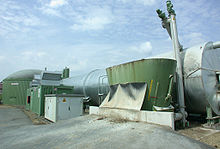
Biogas is methane produced by the process of anaerobic digestion of organic material by anaerobes.[33] It can be produced either from biodegradable waste materials or by the use of energy crops fed into anaerobic digesters to supplement gas yields. The solid byproduct, digestate, can be used as a biofuel or a fertilizer. When CO2 and other impurities are removed from biogas, it is called biomethane.
Biogas can be recovered from mechanical biological treatment waste processing systems. Landfill gas, a less clean form of biogas, is produced in landfills through naturally occurring anaerobic digestion. If it escapes into the atmosphere, it acts as a greenhouse gas.
Farmers can produce biogas from manure from their cattle by using anaerobic digesters.[34]
Syngas
Syngas, a mixture of carbon monoxide, hydrogen and various hydrocarbons, is produced by partial combustion of biomass, that is, combustion with an amount of oxygen that is not sufficient to convert the biomass completely to carbon dioxide and water.[35] Before partial combustion, the biomass is dried, and sometimes pyrolysed. The resulting gas mixture, syngas, is more efficient than direct combustion of the original biofuel; more of the energy contained in the fuel is extracted.
Syngas may be burned directly in internal combustion engines, turbines or high-temperature fuel cells.[36] The wood gas generator, a wood-fueled gasification reactor, can be connected to an internal combustion engine.
Syngas can be used to produce methanol, dimethyl ether and hydrogen, or converted via the Fischer–Tropsch process to produce a diesel substitute, or a mixture of alcohols that can be blended into gasoline. Gasification normally relies on temperatures greater than 700 °C.
Lower-temperature gasification is desirable when co-producing biochar, but results in syngas polluted with tar.
Liquid
Ethanol
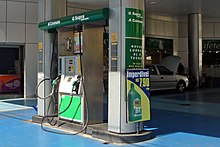
Biologically produced alcohols, most commonly ethanol, and less commonly propanol and butanol, are produced by the action of microorganisms and enzymes through the fermentation of sugars or starches (easiest), or cellulose (which is more difficult).
Ethanol fuel is the most common biofuel worldwide, particularly in Brazil. Alcohol fuels are produced by fermentation of sugars derived from wheat, corn, sugar beets, sugar cane, molasses and any sugar or starch from which alcoholic beverages such as whiskey, can be made (such as potato and fruit waste, etc.). The ethanol production methods used are enzyme digestion (to release sugars from stored starches), fermentation of the sugars, distillation and drying. The distillation process requires significant energy input for heat (sometimes unsustainable natural gas fossil fuel, but cellulosic biomass such as bagasse, the waste left after sugar cane is pressed to extract its juice, is the most common fuel in Brazil, while pellets, wood chips and also waste heat are more common in Europe) Waste steam fuels ethanol factory[37] – where waste heat from the factories also is used in the district heating grid.
Ethanol can be used in petrol engines as a replacement for gasoline; it can be mixed with gasoline to any percentage. Most existing car petrol engines can run on blends of up to 15% bioethanol with petroleum/gasoline. Ethanol has a smaller energy density than that of gasoline; this means it takes more fuel (volume and mass) to produce the same amount of work. An advantage of ethanol (CH
3CH
2OH) is that it has a higher octane rating than ethanol-free gasoline available at roadside gas stations, which allows an increase of an engine's compression ratio for increased thermal efficiency. In high-altitude (thin air) locations, some states mandate a mix of gasoline and ethanol as a winter oxidizer to reduce atmospheric pollution emissions.[citation needed]
Corn-to-ethanol and other food stocks has led to the development of cellulosic ethanol.[38]
Ethanol has roughly one-third lower energy content per unit of volume compared to gasoline. This is partly counteracted by the better efficiency when using ethanol (in a long-term test of more than 2.1 million km, the BEST project found FFV vehicles to be 1–26% more energy efficient than petrol cars, but the volumetric consumption increases by approximately 30%, so more fuel stops are required).[citation needed]
Other bioalcohols
Methanol is currently produced from natural gas, a non-renewable fossil fuel. In the future it is hoped to be produced from biomass as biomethanol. This is technically feasible, but the production is currently being postponed for concerns that the economic viability is still pending.[39] The methanol economy is an alternative to the hydrogen economy to be contrasted with today's hydrogen production from natural gas.
Butanol (C
4H
9OH) is formed by ABE fermentation (acetone, butanol, ethanol) and experimental modifications of the process show potentially high net energy gains with biobutanol as the only liquid product.
Biobutanol is often claimed to provide a direct replacement for gasoline, because it will produce more energy than ethanol and allegedly can be burned "straight" in existing gasoline engines (without modification to the engine or car),[40] and is less corrosive and less water-soluble than ethanol, and could be distributed via existing infrastructures. DuPont and BP are working together to help develop butanol.[citation needed] Escherichia coli strains have also been successfully engineered to produce butanol by modifying their amino acid metabolism.[41] One drawback to butanol production in E. coli remains the high cost of nutrient rich media, however, recent work has demonstrated E. coli can produce butanol with minimal nutritional supplementation.[42]
Biobutanol is sometimes called biogasoline, which is not correct, as it is chemically different, being an alcohol, not a hydrocarbon, like biogasoline.
Biodiesel
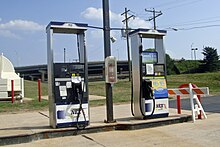
Biodiesel is the most common biofuel in Europe. It is produced from oils or fats using transesterification and is a liquid similar in composition to fossil/mineral diesel. Chemically, it consists mostly of fatty acid methyl (or ethyl) esters (FAMEs).[43] Feedstocks for biodiesel include animal fats, vegetable oils, soy, rapeseed, jatropha, mahua, mustard, flax, sunflower, palm oil, hemp, field pennycress, Pongamia pinnata and algae. Pure biodiesel (B100, also known as "neat" biodiesel) currently reduces emissions with up to 60% compared to diesel Second generation B100.[44] As of 2020[update], researchers at Australia's CSIRO have been studying safflower oil as an engine lubricant, and researchers at Montana State University's Advanced Fuels Center in the US have been studying the oil's performance in a large diesel engine, with results described as a "game-changer".[45]
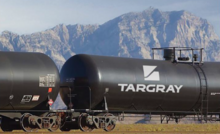
Biodiesel can be used in any diesel engine and modified equipment when mixed with mineral diesel. It can also be used in its pure form (B100) in diesel engines, but some maintenance and performance problems may then occur during wintertime utilization, since the fuel becomes somewhat more viscous at lower temperatures, depending on the feedstock used.[46]
In some countries, manufacturers cover their diesel engines under warranty for B100 use, although Volkswagen of Germany, for example, asks drivers to check by telephone with the VW environmental services department before switching to B100. In most cases, biodiesel is compatible with diesel engines from 1994 onwards, which use 'Viton' (by DuPont) synthetic rubber in their mechanical fuel injection systems. Note however, that no vehicles are certified for using pure biodiesel before 2014, as there was no emission control protocol available for biodiesel before this date.
Electronically controlled 'common rail' and 'Unit Injector' type systems from the late 1990s onwards may only use biodiesel blended with conventional diesel fuel. These engines have finely metered and atomized multiple-stage injection systems that are very sensitive to the viscosity of the fuel. Many current-generation diesel engines are made so that they can run on B100 without altering the engine itself, although this depends on the fuel rail design. Since biodiesel is an effective solvent and cleans residues deposited by mineral diesel, engine filters may need to be replaced more often, as the biofuel dissolves old deposits in the fuel tank and pipes. It also effectively cleans the engine combustion chamber of carbon deposits, helping to maintain efficiency. In many European countries, a 5% biodiesel blend is widely used and is available at thousands of gas stations.[47][48] Biodiesel is also an oxygenated fuel, meaning it contains a reduced amount of carbon and higher hydrogen and oxygen content than fossil diesel. This improves the combustion of biodiesel and reduces the particulate emissions from unburnt carbon. However, using pure biodiesel may increase NOx-emissions[49]
Biodiesel is also safe to handle and transport because it is non-toxic and biodegradable, and has a high flash point of about 300 °F (148 °C) compared to petroleum diesel fuel, which has a flash point of 125 °F (52 °C).[50]
In France, biodiesel is incorporated at a rate of 8% in the fuel used by all French diesel vehicles.[51] Avril Group produces under the brand Diester, a fifth of 11 million tons of biodiesel consumed annually by the European Union.[52] It is the leading European producer of biodiesel.[51]
Green diesel
Green diesel is produced through hydrocracking biological oil feedstocks, such as vegetable oils and animal fats.[53][54] Hydrocracking is a refinery method that uses elevated temperatures and pressure in the presence of a catalyst to break down larger molecules, such as those found in vegetable oils, into shorter hydrocarbon chains used in diesel engines.[55] It may also be called renewable diesel, hydrotreated vegetable oil (HVO fuel)[55] or hydrogen-derived renewable diesel.[54] Unlike biodiesel, green diesel has exactly the same chemical properties as petroleum-based diesel.[55][56] It does not require new engines, pipelines or infrastructure to distribute and use, but has not been produced at a cost that is competitive with petroleum.[54] Gasoline versions are also being developed.[57] Green diesel is being developed in Louisiana and Singapore by ConocoPhillips, Neste Oil, Valero, Dynamic Fuels, and Honeywell UOP[54][58] as well as Preem in Gothenburg, Sweden, creating what is known as Evolution Diesel.[59]
Straight vegetable oil

Straight unmodified edible vegetable oil is generally not used as fuel, but lower-quality oil has been used for this purpose. Used vegetable oil is increasingly being processed into biodiesel, or (more rarely) cleaned of water and particulates and then used as a fuel.[citation needed]
As with 100% biodiesel (B100), to ensure the fuel injectors atomize the vegetable oil in the correct pattern for efficient combustion, vegetable oil fuel must be heated to reduce its viscosity to that of diesel, either by electric coils or heat exchangers. This is easier in warm or temperate climates. MAN B&W Diesel, Wärtsilä, and Deutz AG, as well as a number of smaller companies, such as Elsbett, offer engines that are compatible with straight vegetable oil, without the need for after-market modifications.[citation needed]
Vegetable oil can also be used in many older diesel engines that do not use common rail or unit injection electronic diesel injection systems. Due to the design of the combustion chambers in indirect injection engines, these are the best engines for use with vegetable oil. This system allows the relatively larger oil molecules more time to burn. Some older engines, especially Mercedes, are driven experimentally by enthusiasts without any conversion. A handful of drivers have experienced limited success with earlier pre-"Pumpe Duse" VW TDI engines and other similar engines with direct injection. Several companies, such as Elsbett or Wolf, have developed professional conversion kits and successfully installed hundreds of them over the last decades.[citation needed]
Oils and fats reacted with 10 pounds of a short-chain alcohol (usually methanol) in the presence of a catalyst (usually sodium hydroxide [NaOH] can be hydrogenated to give a diesel substitute.[61] The resulting product is a straight-chain hydrocarbon with a high cetane number, low in aromatics and sulfur and does not contain oxygen. Hydrogenated oils can be blended with diesel in all proportions. They have several advantages over biodiesel, including good performance at low temperatures, no storage stability problems and no susceptibility to microbial attack.[35]
Biogasoline
A study led by Professor Lee Sang-yup at the Korea Advanced Institute of Science and Technology (KAIST) and published in the international science journal Nature used modified E. coli fed with glucose found in plants or other non-food crops to produce biogasoline with the produced enzymes. The enzimes converted the sugar into fatty acids and then turned these into hydrocarbons that were chemically and structurally identical to those found in commercial gasoline fuel.[62]
Bioethers

Bioethers (also referred to as fuel ethers or oxygenated fuels) are cost-effective compounds that act as octane rating enhancers. "Bioethers are produced by the reaction of reactive iso-olefins, such as iso-butylene, with bioethanol."[63][attribution needed] Bioethers are created from wheat or sugar beets, and also be produced from the waste glycerol that results from the production of biodiesel.[64] They also enhance engine performance, while significantly reducing engine wear and toxic exhaust emissions. Although bioethers are likely to replace petroethers in the UK, it is highly unlikely they will become a fuel in and of itself due to the low energy density.[65] By greatly reducing the amount of ground-level ozone emissions, they contribute to air quality.[66][67]
When it comes to transportation fuel there are six ether additives: dimethyl ether (DME), diethyl ether (DEE), methyl tert-butyl ether (MTBE), ethyl tert-butyl ether (ETBE), tert-amyl methyl ether (TAME), and tert-amyl ethyl ether (TAEE).[68]
The European Fuel Oxygenates Association identifies MTBE and ETBE as the most commonly used ethers in fuel to replace lead. Ethers were introduced in Europe in the 1970s to replace the highly toxic compound.[69] Although Europeans still use bioether additives, the U.S. Energy Policy Act of 2005 lifted a requirement for reformulated gasoline to include an oxygenate, leading to less MTBE being added to fuel.[70]
See also
- Bioenergy Europe
- BioEthanol for Sustainable Transport
- Biofuels Center of North Carolina
- Biofuelwatch
- Biogas powerplant
- Ecological sanitation
- International Renewable Energy Agency
- Issues relating to biofuels
- List of biofuel companies and researchers
- List of emerging technologies
- List of vegetable oils used for biofuel
- Renewable energy by country
- Renewable Energy Transition
- Residue-to-product ratio
- Sustainable aviation fuel
- Sustainable transport
- Table of biofuel crop yields
References
- ^ "Biofules explained". U.S. Energy Information Administration. Archived from the original on 2 June 2019.
Biofuels are transportation fuels such as ethanol and biodiesel that are made from biomass materials.
- ^ "What is biofuel? definition and meaning". BusinessDictionary.com. Archived from the original on 23 April 2015. Retrieved 30 May 2015.
- ^ "Liquid biofuel production, 2020, and in the Net Zero Scenario, 2030 – Charts – Data & Statistics". IEA. 3 November 2021. Retrieved 29 March 2022.
- ^ Bayetero CM, Yépez CM, Cevallos IB, Rueda EH (January 2022). "Effect of the use of additives in biodiesel blends on the performance and opacity of a diesel engine". Materials Today: Proceedings. Advances in Mechanical Engineering Trends. 49: 93–99. doi:10.1016/j.matpr.2021.07.478. ISSN 2214-7853. S2CID 238787289.
- ^ IEA (2021), Transport Biofuels, IEA, Paris https://www.iea.org/reports/transport-biofuels
- ^ Rodionova MV, Poudyal RS, Tiwari I, Voloshin RA, Zharmukhamedov SK, Nam HG, et al. (23 March 2017). "Biofuel production: Challenges and opportunities". International Journal of Hydrogen Energy. 42 (12): 8450–8461. doi:10.1016/j.ijhydene.2016.11.125. ISSN 0360-3199.
- ^ IEA (2021). Transport Biofuels. International Energy Agency (IEA) (Report). Paris.
- ^ "What are – and who's making – 2G, 3G and 4G biofuels? : Biofuels Digest - biofuels, biodiesel, ethanol, algae, jatropha, green gasoline, green diesel, and biocrude daily news". 21 May 2010. Archived from the original on 21 May 2010.
- ^ "Food vs fuel: Ukraine war sharpens debate on use of crops for energy". Financial Times. 12 June 2022.
- ^ "Guest view: Global hunger fight means no biofuel". Reuters. 6 June 2022.
- ^ "Cutting biofuels can help avoid global food shock from Ukraine war". New Scientist. 14 March 2022.
- ^ i.e. arid lands in case of jatropha, or hilly terrain not accessible by tractor, ... in case of grasses, woody crops ...
- ^ "Biofuels – Second Generation Biofuels". biofuel.org.uk. Archived from the original on 15 July 2019. Retrieved 18 January 2018.
- ^ Antizar-Ladislao B, Turrion-Gomez JL (September 2008). "Second-generation biofuels and local bioenergy systems". Biofuels, Bioproducts and Biorefining. 2 (5): 455–469. doi:10.1002/bbb.97. S2CID 84426763.
- ^ Bryngemark E (December 2019). "Second generation biofuels and the competition for forest raw materials: A partial equilibrium analysis of Sweden". Forest Policy and Economics. 109: 102022. doi:10.1016/j.forpol.2019.102022. ISSN 1389-9341. S2CID 212954432.
- ^ inod P, Gnansounou E, Sindhu R, Pandey A (February 2019). "Enzymes for second generation biofuels: Recent developments and future perspectives". Bioresource Technology Reports. 5: 317–325. doi:10.1016/j.biteb.2018.06.005. ISSN 2589-014X. S2CID 133996549.
- ^ a b "Biofuel from Algae: The Pros and Cons of Pond Scum". Thomasnet®. Archived from the original on 6 April 2020. Retrieved 25 October 2020.
- ^ "Biomass - Offshore wind farms = seaweed = biofuel". Renewable Energy Magazine, at the heart of clean energy journalism. 14 September 2020. Archived from the original on 27 July 2020. Retrieved 16 October 2020.
- ^ Greenwell HC, Laurens LM, Shields RJ, Lovitt RW, Flynn KJ (May 2010). "Placing microalgae on the biofuels priority list: a review of the technological challenges". Journal of the Royal Society, Interface. 7 (46): 703–726. doi:10.1098/rsif.2009.0322. PMC 2874236. PMID 20031983.
- ^ Yang J, Xu M, Zhang X, Hu Q, Sommerfeld M, Chen Y (January 2011). "Life-cycle analysis on biodiesel production from microalgae: water footprint and nutrients balance" (PDF). Bioresource Technology. 102 (1): 159–165. doi:10.1016/j.biortech.2010.07.017. PMID 20675125. Archived from the original (PDF) on 27 February 2012.
- ^ Cornell CB (29 March 2008). "First Algae Biodiesel Plant Goes Online: 1 April 2008". Gas 2.0. Archived from the original on 18 June 2019. Retrieved 10 June 2008.
- ^ Dinh LT, Guo Y, Mannan MS (2009). "Sustainability evaluation of biodiesel production using multicriteria decision-making". Environmental Progress & Sustainable Energy. 28: 38–46. doi:10.1002/ep.10335. S2CID 111115884.
- ^ Demirbas AH (2011). "Biodiesel from oilgae, biofixation of carbon dioxide by microalgae: A solution to pollution problems". Applied Energy. 88 (10): 3541–3547. doi:10.1016/j.apenergy.2010.12.050. hdl:11503/1330.
- ^ Demirbas AH (2009). "Inexpensive oil and fats feedstocks for production of biodiesel". Energy Education Science and Technology Part A: Energy Science and Research. 23: 1–13.
- ^ Wesoff E (19 April 2017). "Hard Lessons From the Great Algae Biofuel Bubble". Archived from the original on 5 July 2017. Retrieved 5 August 2017.
- ^ Lü J, Sheahan C, Fu P (2011). "Metabolic engineering of algae for fourth generation biofuels production". Energy & Environmental Science. 4 (7): 2451. doi:10.1039/c0ee00593b. ISSN 1754-5692.
- ^ a b c Aro EM (January 2016). "From first generation biofuels to advanced solar biofuels". Ambio. 45 (Supplement 1): S24–S31. doi:10.1007/s13280-015-0730-0. PMC 4678123. PMID 26667057.
- ^ a b Abdullah B, Muhammad SA, Shokravi Z, Ismail S, Kassim KA, Mahmood AN, Aziz MM (June 2019). "Fourth generation biofuel: A review on risks and mitigation strategies". Renewable and Sustainable Energy Reviews. 107: 37–50. doi:10.1016/j.rser.2019.02.018. S2CID 116245776.
- ^ a b c d Jeswani HK, Chilvers A, Azapagic A (November 2020). "Environmental sustainability of biofuels: a review". Proceedings. Mathematical, Physical, and Engineering Sciences. 476 (2243): 20200351. doi:10.1098/rspa.2020.0351. PMC 7735313. PMID 33363439.
- ^ Lewandrowski J, Rosenfeld J, Pape D, Hendrickson T, Jaglo K, Moffroid K (25 March 2019). "The greenhouse gas benefits of corn ethanol – assessing recent evidence". Biofuels. 11 (3). Informa UK Limited: 361–375. doi:10.1080/17597269.2018.1546488. ISSN 1759-7269. S2CID 134824935.
- ^ Lark TJ, Hendricks NP, Smith A, Pates N, Spawn-Lee SA, Bougie M, et al. (March 2022). "Environmental outcomes of the US Renewable Fuel Standard". Proceedings of the National Academy of Sciences of the United States of America. 119 (9). Bibcode:2022PNAS..11901084L. doi:10.1073/pnas.2101084119. PMC 8892349. PMID 35165202.
- ^ Ethanol for instance can be produced using 1G, 2G and 3G procedures
- ^ Redman, G., The Andersons Centre. "Assessment of on-farm AD in the UK", National Non-Food Crops Centre, 9 June 2008. Retrieved 2009-05-11.
- ^ "BIOGAS: No bull, manure can power your farm." Farmers Guardian (25 September 2009): 12. General OneFile. Gale.
- ^ a b Evans G (14 April 2008). Liquid Transport Biofuels – Technology Status Report (Report). National Non-Food Crops Centre. Archived from the original on 11 June 2008.
- ^ Nagel F (2008). Electricity from wood through the combination of gasification and solid oxide fuel cells (PhD thesis). Swiss Federal Institute of Technology Zurich. Archived from the original on 13 March 2011.
- ^ "Energikunskap | Lär dig mer om energi – E.ON". Archived from the original on 27 October 2014. Retrieved 21 June 2014.
- ^ Houghton J, Weatherwax S, Ferrell J (7 June 2006). Breaking the biological barriers to cellulosic ethanol: a joint research agenda (Report). Washington, DC (United States): EERE Publication and Product Library. doi:10.2172/1218382.
- ^ Börjesson P, Lundgren J, Ahlgren S, Nyström I (18 June 2013). Dagens och framtidens hållbara biodrivmedel: underlagsrapport från f3 till utredningen om fossilfri fordonstrafik [Today's and the future's sustainable biofuels: background report from f3 to the inquiry into fossil-free vehicle traffic.] (Report) (in Swedish). Vol. 13. The Swedish Knowledge Centre for Renewable Transportation Fuels. p. 170.
- ^ "ButylFuel, LLC Main Page". Butanol.com. 15 August 2005. Archived from the original on 10 July 2019. Retrieved 14 July 2010.
- ^ Evans J (14 January 2008). "Biofuels aim higher". Biofuels, Bioproducts and Biorefining (BioFPR). Archived from the original on 10 August 2009. Retrieved 3 December 2008.
- ^ Pontrelli S, Fricke RC, Sakurai SS, Putri SP, Fitz-Gibbon S, Chung M, et al. (September 2018). "Directed strain evolution restructures metabolism for 1-butanol production in minimal media". Metabolic Engineering. 49: 153–163. doi:10.1016/j.ymben.2018.08.004. PMID 30107263.
- ^ Fukuda H, Kondo A, Noda H (January 2001). "Biodiesel fuel production by transesterification of oils". Journal of Bioscience and Bioengineering. 92 (5): 405–416. doi:10.1016/s1389-1723(01)80288-7. PMID 16233120.
- ^ "Perstop Press release: Verdis Polaris Aura – second generation B100 – The advanced green one". Archived from the original on 4 August 2014. Retrieved 21 June 2014.
- ^ Lee T (7 June 2020). "Safflower oil hailed by scientists as possible recyclable, biodegradable replacement for petroleum". ABC News. Landline. Australian Broadcasting Corporation. Archived from the original on 7 June 2020. Retrieved 7 June 2020.
- ^ "Alternative Fuels Data Center: Biodiesel Blends". afdc.energy.gov. Retrieved 31 March 2022.
- ^ "ADM Biodiesel: Hamburg, Leer, Mainz". Biodiesel.de. Archived from the original on 2 August 2009. Retrieved 14 July 2010.
- ^ RRI Limited for Biodiesel Filling Stations. "Welcome to Biodiesel Filling Stations". Biodieselfillingstations.co.uk. Archived from the original on 14 July 2018. Retrieved 14 July 2010.
- ^ Nylund NO, Koponen K (2012). Fuel and Technology Alternatives for Buses. Overall Energy Efficiency and Emission Performance. IEA Bioenergy Task 46 (PDF) (Report). VTT Technical Research Centre of Finland. Archived from the original (PDF) on 16 February 2020.. Possibly the new emission standards Euro VI/EPA 10 will lead to reduced NOx-levels also when using B100.
- ^ "Biofuels Facts". Hempcar.org. Archived from the original on 20 May 2011. Retrieved 14 July 2010.
- ^ a b Avril Group : Activity Report 2014, p. 58
- ^ EurObserv 2014, p. 4
- ^ Brown R, Holmgren J. "Fast Pyrolysis and Bio-Oil Upgrading" (PDF). Archived (PDF) from the original on 5 January 2012. Retrieved 15 March 2012.
- ^ a b c d "Alternative & Advanced Fuels". US Department of Energy. Archived from the original on 27 October 2012. Retrieved 7 March 2012.
- ^ a b c Knothe G (June 2010). "Biodiesel and renewable diesel: a comparison". Progress in Energy and Combustion Science. 36 (3): 364–373. doi:10.1016/j.pecs.2009.11.004. Archived from the original on 6 November 2012. Retrieved 23 August 2012.
- ^ "Green Diesel v. Biodiesel". Archived from the original on 5 August 2018. Retrieved 5 August 2018.
- ^ Jessica E. "Breakthroughs in Green Gasoline Production". Biomass Magazine. Archived from the original on 11 March 2012. Retrieved 14 August 2012.
- ^ Albrecht KO, Hallen RT (March 2011). A Brief Literature Overview of Various Routes to Biorenewable Fuels from Lipids for the National Alliance of Advanced Biofuels and Bio-products NAAB Consortium (PDF) (Report). Prepared by the US Department of Energy. Archived (PDF) from the original on 12 July 2012. Retrieved 23 August 2012.
- ^ "Preem makes major investment in green diesel at the Port of Gothenburg – Port of Gothenburg". August 2014. Archived from the original on 1 August 2014.
- ^ "Wal-Mart To Test Hybrid Trucks". Sustainable Business. 3 February 2009. Archived from the original on 8 May 2014. Retrieved 8 May 2014.
- ^ "Alternative Fuels Data Center: Biodiesel Production and Distribution". afdc.energy.gov. Retrieved 31 March 2022.
- ^ Liquid Transport Fuels&Lubes - South Korean scientists use E. coli to make gasoline (Report). Fuels&Lubes Daily. 4 November 2013. Archived from the original on 7 September 2022.
- ^ Rock K, Korpelshoek M (2007). "Bioethers Impact on the Gasoline Pool". Digital Refining. Archived from the original on 14 November 2016. Retrieved 15 February 2014.
- ^ "Biofuels - Types of Biofuels - Bioethers". biofuel.org.uk. Archived from the original on 1 February 2016.
- ^ "Biofuels – Types of Biofuels – Bioethers". Archived from the original on 1 February 2016. Retrieved 30 May 2015.
- ^ "Council Directive 85/536/EEC of 5 December 1985 on crude-oil savings through the use of substitute fuel components in petrol". Eur-lex.europa.eu. Archived from the original on 21 May 2011. Retrieved 14 July 2010.
- ^ "Impact Assessment of the Proposal for a Directive of the European Parliament and of the Council modifying Directive 98/70/EC relating to the quality of petrol and diesel fuels" (PDF). Brussels: Commission of the European Communities. 31 January 2007. Archived (PDF) from the original on 15 July 2011. Retrieved 14 July 2010.
- ^ Sukla MK, Bhaskar T, Jain AK, Singal SK, Garg MO. "Bio-Ethers as Transportation Fuel: A Review" (PDF). Indian Institute of Petroleum Dehradun. Archived (PDF) from the original on 14 October 2011. Retrieved 15 February 2014.
- ^ "What are Bio-Ethers?" (PDF). . The European Fuel Oxygenates Association. Archived from the original (PDF) on 6 March 2014.
- ^ "Gasoline". Environmental Protection Agency. Archived from the original on 6 December 2013. Retrieved 6 March 2014.
Sources
- Avril Group, ed. (2015). A new springtime for the oils and proteins sectors : Activity Report 2014 (PDF) (Report). Paris: Avril. p. 65.
- EurObserv (July 2014). Biofuel barometer (PDF) (Report).
Further reading
- Mansoori GA, Enayati N, Agyarko LB (2016). Energy: Sources, Utilization, Legislation, Sustainability, Illinois as Model State. World Sci. Pub. Co. doi:10.1142/9699. ISBN 978-981-4704-00-7.
- Drapcho C, Nghiêm NP, Walker T (August 2008). Biofuels Engineering Process Technology. [McGraw-Hill]. ISBN 978-0-07-148749-8.
- IChemE Energy Conversion Technology Subject Group (May 2009). A Biofuels Compendium. [IChemE]. ISBN 978-0-85295-533-8. Archived from the original on 19 July 2011.
- "Fuel Quality Directive Impact Assessment" (PDF). Commission of the European Communities. 31 January 2007.
- Mitchell D (2010). Biofuels in Africa: Opportunities, Prospects, and Challenges. Washington, D.C.: The World Bank. ISBN 978-0-8213-8516-6. Archived from the original (Available in PDF) on 11 August 2011. Retrieved 8 February 2011.
- Li H, Cann AF, Liao JC (2010). "Biofuels: biomolecular engineering fundamentals and advances". Annual Review of Chemical and Biomolecular Engineering. 1: 19–36. doi:10.1146/annurev-chembioeng-073009-100938. PMID 22432571.
External links
- Biofuels Journal
- Alternative Fueling Station Locator Archived 14 July 2008 at the Wayback Machine (EERE)
- Towards Sustainable Production and Use of Resources: Assessing Biofuels by the United Nations Environment Programme, October 2009.
- Biofuels guidance for businesses, including permits and licences required on NetRegs.gov.uk
- How Much Water Does It Take to Make Electricity?—Natural gas requires the least water to produce energy, some biofuels the most, according to a new study.
- International Conference on Biofuels Standards – European Union Biofuels Standardization
- Biofuels from Biomass: Technology and Policy Considerations Thorough overview from MIT
- The Guardian news on biofuels
- The US DOE Clean Cities Program – links to the 87 US Clean Cities coalitions, as of 2004.
- Biofuels Factsheet by the University of Michigan's Center for Sustainable Systems
- Learn Biofuels – Educational Resource for Students

